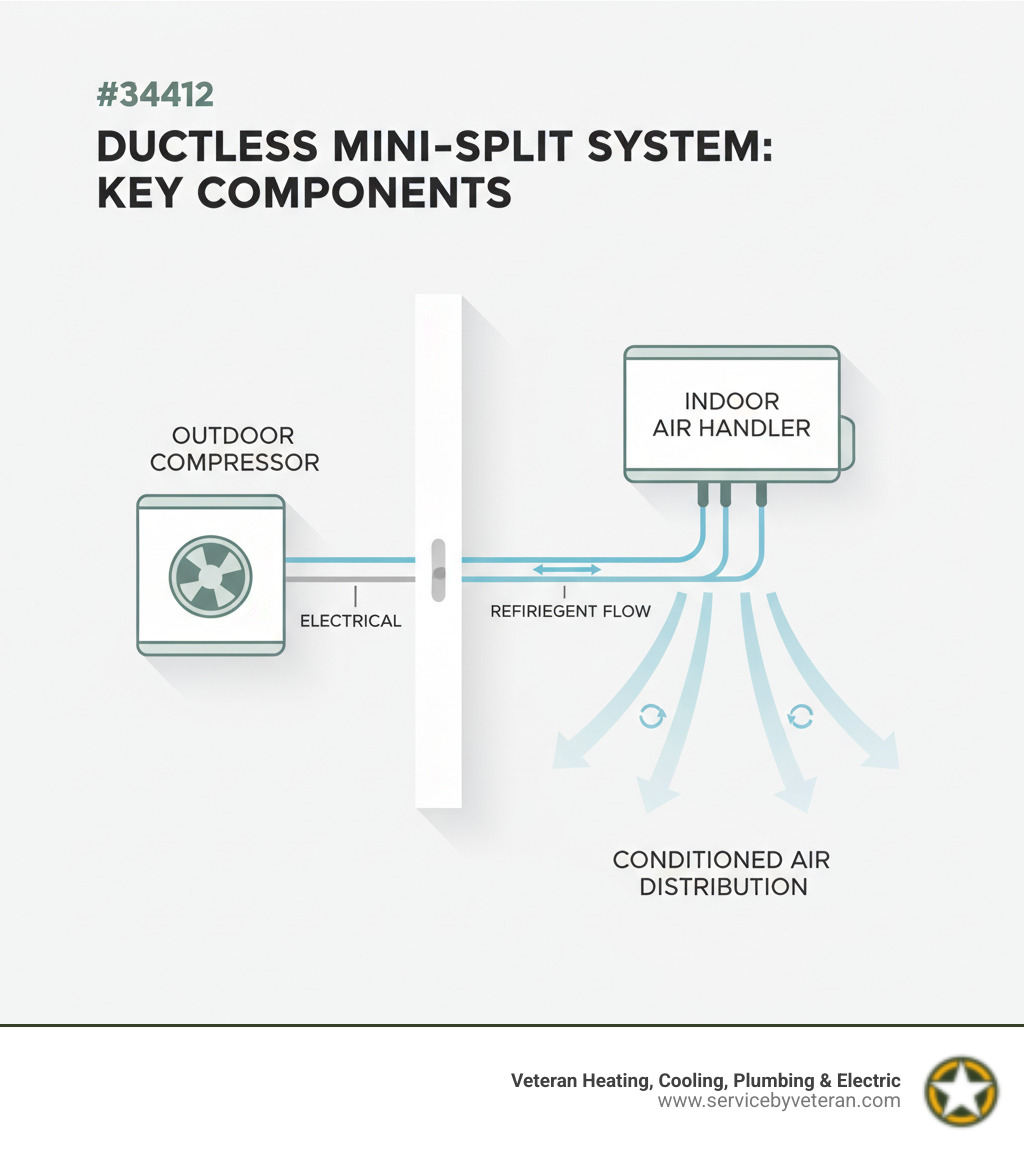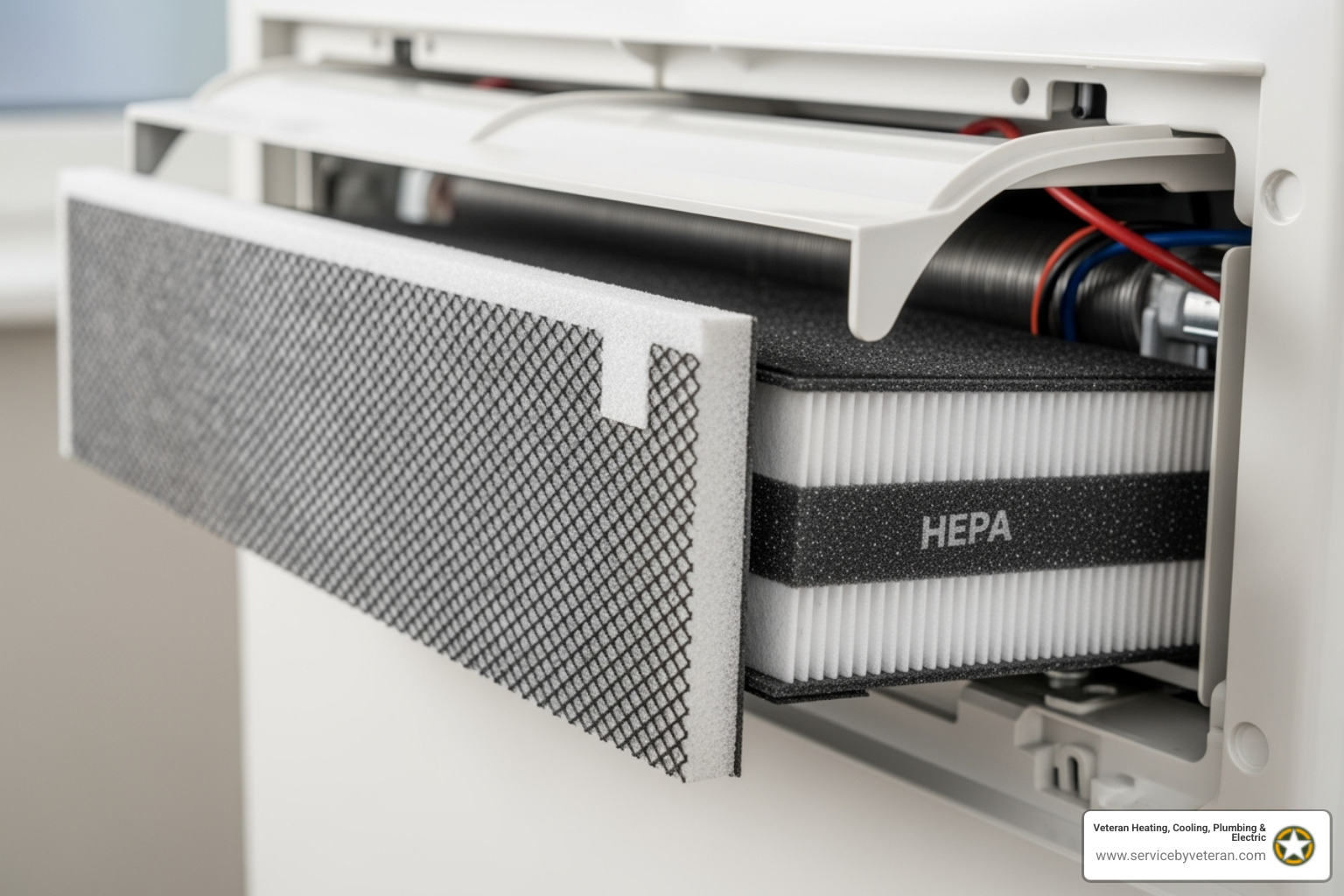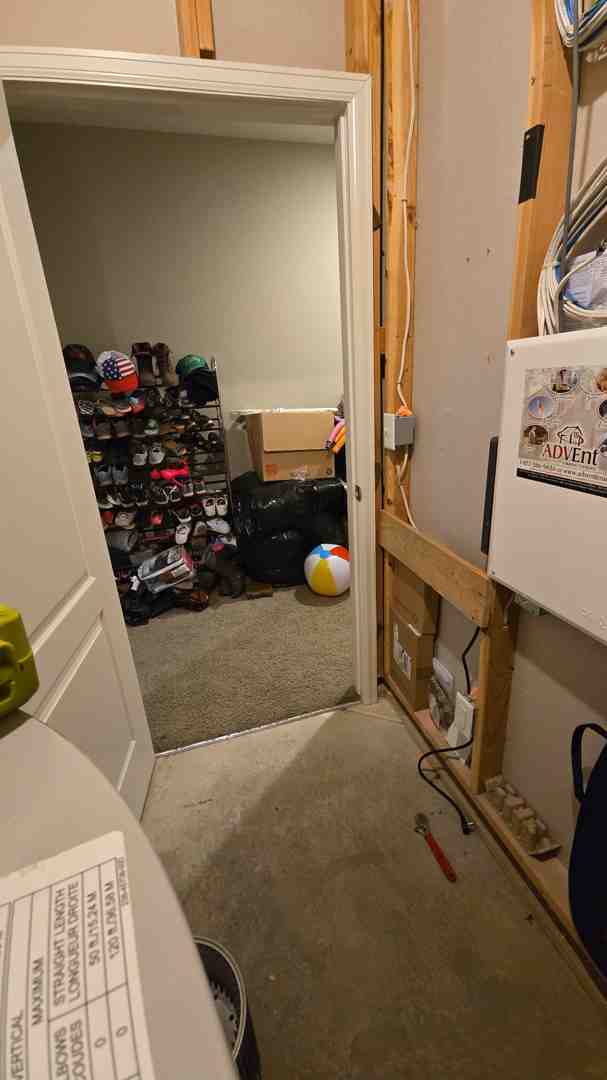Why Homeowners Are Choosing Ductless Systems
Ductless heating and cooling systems are a modern, efficient alternative to traditional HVAC. They use individual wall-mounted units connected to an outdoor compressor, eliminating the need for bulky ductwork. Instead of generating heat, these systems transfer it, making them highly efficient.
Key Benefits:
- Energy Savings: Use up to 60% less energy than electric baseboard heaters.
- Zoned Comfort: Control temperature independently in each room.
- Easy Installation: Requires only a small hole in the wall.
- Improved Air Quality: Built-in filters trap dust and allergens.
- Versatile Applications: Ideal for older homes, additions, or problem areas.
Ductless technology solves common issues like uneven temperatures and high energy bills by eliminating ductwork losses, which can account for over 30% of heating and cooling costs.
I'm Mike Townsend. My U.S. Army experience with precision cooling systems and years of helping Denver-area homeowners optimize their HVAC gives me unique insight into why ductless technology is a reliable, efficient choice for many homes.

Ductless heating and cooling glossary:
How Ductless Heating and Cooling Works
Ductless heating and cooling systems work by moving heat, not creating it. In winter, the system pulls heat from the outdoor air and brings it inside. In summer, it reverses the process, pulling heat from your home and releasing it outdoors. This heat-transfer process is managed by a quiet, continuous refrigerant cycle.

The Core Components of a Mini-Split System
A mini-split system has four main parts:
- The outdoor unit houses the compressor, the heart of the system. It moves refrigerant to either absorb or release heat. Modern units are remarkably quiet, often running at around 46 decibels—as loud as a normal conversation.
- The indoor units are the sleek, wall-mounted air handlers you see inside. A whisper-quiet fan distributes conditioned air directly into the room.
- The conduit connects the outdoor and indoor units through a small three-inch hole in the wall. It contains the refrigerant tubing, power cable, and a condensate drain line.
- Your control system, typically a remote for each unit, allows you to set the temperature for that specific space. Many systems also offer smartphone apps like the Comfort app for control from anywhere.
Ductless vs. Traditional Ducted Systems
The primary difference is how conditioned air is delivered. Traditional systems push air through a network of ducts, while ductless systems deliver it directly into the room.
- Installation: Ductless systems require only a small hole and can often be installed in a day. Ducted systems require extensive work that can take several days.
- Energy efficiency: Ductless systems eliminate energy loss from leaky ducts, which can waste up to 30% of conditioned air in traditional systems.
- Zoning: Ductless provides independent control for each room. Traditional systems typically use one thermostat for the whole house.
- Upfront cost: Ductless systems may cost more than a basic traditional system but less than installing a new ducted system from scratch. Energy savings provide a return on the investment.
- Indoor air quality: Ductless units have multi-stage filtration and avoid the dust and allergens that can build up in ductwork.
The Role of Inverter Technology
Modern ductless heating and cooling systems use inverter technology, which allows the compressor to adjust its speed continuously rather than cycling on and off. This is like cruise control for your home's comfort. The system runs at lower, more efficient speeds to maintain a consistent temperature, eliminating uncomfortable hot and cold swings. This process uses significantly less energy and allows the system to operate much more quietly than traditional HVAC units.
The Major Benefits of Going Ductless
For homeowners in Denver, Littleton, and Broomfield, switching to ductless heating and cooling means a more comfortable home, smaller energy bills, and cleaner air. It's a fundamental shift in home comfort.
Superior Energy Efficiency and Cost Savings
Ductless systems deliver impressive cost savings. Mini-split heat pumps can use up to 60% less energy than standard electric baseboard heaters and cut cooling costs by about 30% compared to window AC units. The main reason is the elimination of ductwork, which can lose over 30% of conditioned air through leaks. This direct delivery can reduce your total energy consumption significantly.
Modern ductless heating and cooling systems have high efficiency ratings, with SEER2 (cooling efficiency) ratings above 35 and HSPF2 (heating efficiency) ratings exceeding 22. Higher scores mean better performance and more money saved. While the upfront investment may be higher, the monthly utility savings often provide a quick return, making it a smart investment over the system's 10- to 15-year lifespan.
For more details, see our guides on Ductless Air Conditioning Installation and Mini Split Installation Cost.
Personalized Comfort with Room-by-Room Zoning
Ductless heating and cooling solves the problem of uneven temperatures throughout a house. The magic is in zoning—the ability to control temperatures in different areas independently. A single-zone system is perfect for one area, like an addition or garage, while multi-zone systems use one outdoor unit to power several indoor units for whole-home comfort.
Each indoor unit has its own thermostat, giving you independent temperature control. You can cool an office during the day without wasting energy on empty rooms. This eliminates hot and cold spots and reduces energy bills by only conditioning occupied spaces.
Improved Indoor Air Quality
Ductless heating and cooling systems also improve the air you breathe.

Each indoor unit has a multi-stage filtration system that traps dust, pollen, pet dander, and other allergens at the source. Unlike ducted systems that can circulate irritants, ductless units filter the air within a single room.
Because each zone operates independently, there is no cross-contamination between rooms. Air from the kitchen doesn't mix with air in the bedroom. This is a significant benefit for families with allergies or respiratory sensitivities, creating a fresher, cleaner home environment. For more on this topic, explore our page on Air Quality Improvement.
Types of Ductless Systems and Ideal Applications
Ductless heating and cooling systems are highly adaptable, offering a solution for nearly any home, from historic cottages in Edgewater to modern homes in Greenwood Village.

Single-Zone vs. Multi-Zone Configurations
- Single-zone systems use one outdoor unit connected to one indoor unit. They are perfect for conditioning a single space, such as a new addition, a converted garage, or a sunroom.
- Multi-zone systems connect one outdoor unit to multiple indoor units (up to eight). This provides a whole-home solution with independent temperature control for each room, eliminating the need to install ductwork.
Choosing Your Indoor Unit Style
You can choose from several indoor unit styles to match your space and aesthetic preferences:
- High-wall units: The most common type, mounted high on a wall for efficient air distribution.
- Floor-mounted consoles: Sit at floor level, ideal for rooms with limited wall space, such as those with large windows or sloped ceilings.
- Ceiling cassettes: Installed flush with the ceiling, with only a slim grille visible. They are great for large, open spaces where you want a discreet look.
- Concealed ducted units: Hidden in a ceiling or attic, these units use short, flexible ducts to deliver air through traditional-looking vents, combining ductless efficiency with a conventional appearance.
When is ductless heating and cooling the best choice?
Ductless systems are an ideal solution in several common situations:
- Older homes without existing ductwork: Provides modern comfort without the cost and disruption of retrofitting ducts.
- Home additions and converted spaces: Offers an easy way to add climate control to new or repurposed rooms like offices or master suites.
- Supplementing your existing system: Solves persistent hot or cold spots in specific rooms without replacing your entire HVAC system.
- Replacing expensive heating: An efficient alternative to electric baseboard heaters or oil furnaces that can dramatically lower energy bills.
- New construction: The precise zoning and high efficiency of ductless systems are perfect for modern, well-insulated homes.
Key Considerations Before You Install
Before installing a ductless heating and cooling system, a few key decisions will ensure it performs perfectly for your home. Professional consultation is critical to get these details right from the start.
For more technical information, the U.S. Department of Energy offers a great resource on ductless mini-split air conditioners.
Sizing Your System for Optimal Performance
Properly sizing a ductless heating and cooling system is crucial for efficiency and comfort. A professional will perform a Manual J load calculation, which analyzes factors like your home's insulation, windows, ceiling height, and climate zone to determine the exact heating and cooling capacity you need.
- An oversized system will short-cycle (turn on and off frequently), wasting energy, failing to dehumidify properly, and causing premature wear.
- An undersized system will run constantly without being able to reach the desired temperature, leading to discomfort and high energy bills.
Correct sizing ensures your system runs efficiently, provides consistent comfort, and lasts for its full lifespan.
Understanding Key Energy Efficiency Ratings
When comparing systems, look for these key ratings. Higher numbers mean greater efficiency and lower utility bills.
- SEER2 (Seasonal Energy Efficiency Ratio): Measures cooling efficiency over a season. Modern ductless systems can exceed a SEER2 of 35.
- EER2 (Energy Efficiency Ratio): Measures cooling efficiency at peak operating conditions on a very hot day.
- HSPF2 (Heating Seasonal Performance Factor): Measures a heat pump's heating efficiency over a season. Top models can achieve an HSPF2 above 22.
Systems with the ENERGY STAR Most Efficient label represent the best in energy savings.
Special Considerations for Cold Climates
Modern ductless heating and cooling systems are fully capable of handling Colorado winters. Advanced cold-climate heat pump models are engineered to extract heat from the air even at very low temperatures.
Many of these systems maintain nearly 100% of their heating capacity well below freezing, with some models operating effectively down to -22°F. For the rare, extremely cold days in the Denver area, having a backup heat source, like an existing furnace or boiler, can provide extra peace of mind and ensure optimal efficiency.
If you plan to use a boiler as a backup, we can ensure it's in top condition. Learn more about our Boiler Repair services.
Cost, Maintenance, and Long-Term Value
Choosing ductless heating and cooling is an investment in long-term comfort and lower utility bills. With proper care, these systems provide 10 to 15 years or more of dependable service.
The Cost of Ductless Heating and Cooling
The upfront cost of a mini-split system depends on the number of indoor units and the complexity of the installation. For homes without existing ductwork, installing a ductless system is often less expensive and less disruptive than retrofitting a traditional ducted system.
The true financial benefit is seen on your monthly utility bills. By eliminating the 30%+ energy loss common with ducts, these systems deliver immediate and ongoing savings. Over the system's lifespan, the return on investment from energy savings makes it a smart financial decision.
Simple Maintenance for Longevity
Maintaining your ductless system is straightforward.
- DIY Task: Clean the filters on your indoor units every few weeks during peak season. Simply rinse them with water, let them dry, and slide them back in. This simple step maintains airflow and air quality.
- Professional Maintenance: Schedule an annual check-up with a qualified technician. We will clean the indoor and outdoor coils, check refrigerant levels, inspect electrical connections, and perform a deep cleaning of components like the blower wheel every 1-3 years. This preventative care helps avoid costly breakdowns.
If you ever need emergency service, our 24 Hour HVAC Repair team is always available.
Available Rebates and Incentives
You can significantly reduce the initial cost of a new system through various financial incentives. High-efficiency ductless heating and cooling systems, especially those with ENERGY STAR certification, often qualify for rebates.
The federal government offers tax credits of up to $2,000 for qualifying air source heat pumps. Additionally, local utility companies in areas like Denver and Arvada often have their own rebate programs. You can use the ENERGY STAR Rebate Finder by entering your zip code to see all available incentives in your area.
Frequently Asked Questions about Ductless Systems
Here are answers to some of the most common questions we hear from homeowners considering ductless heating and cooling.
Are ductless systems noisy?
No, ductless systems are remarkably quiet. Indoor units operate at levels between 19 and 26 decibels, which is quieter than a library. Modern outdoor units are also very quiet, running at around 46 decibels—about the same as a normal conversation. We strategically place the outdoor unit to minimize any potential sound disruption.
What are the main drawbacks of a mini-split system?
While the benefits are significant, there are a few considerations:
- Initial Cost: The upfront investment is higher than for a window AC unit, but the long-term energy savings and dual heating/cooling function provide a strong return.
- Aesthetics: The indoor units are visible on the wall, floor, or ceiling. While modern designs are sleek, they are more noticeable than traditional vents.
- Professional Installation: A ductless system is not a DIY project. It requires a licensed professional for proper sizing, installation, and maintenance to ensure efficiency and warranty coverage.
Can a ductless system heat and cool an entire house?
Absolutely. A properly designed multi-zone system can serve as the primary, whole-home climate solution. By connecting multiple indoor units to a single outdoor unit, you can achieve customized comfort in every room, eliminating the need for a traditional furnace and ductwork. Ductless systems are also excellent for supplementing an existing HVAC system to solve problem spots in specific rooms.
Conclusion
Ductless heating and cooling offers a transformative approach to home comfort. By eliminating the 30% energy loss from traditional ductwork, these systems deliver significant savings on your monthly bills. Combined with room-by-room temperature control and improved air quality, ductless technology provides a practical, proven solution for many common household comfort issues.
Whether you have an older home, are adding new living space, or simply want more control over your comfort and energy costs, a ductless system can be customized to fit your needs. From single-zone units for problem areas to comprehensive multi-zone systems for whole-home comfort, there is a flexible configuration for your home and budget.
At Veteran Heating, Cooling, Plumbing & Electric, we help homeowners make smart decisions. We provide honest assessments, expert installation, and ongoing support backed by our lifetime warranty on parts and labor. It's how we've earned the trust of families throughout Aurora, Littleton, Boulder, and across the Front Range.
If you're curious whether ductless heating and cooling is right for you, contact us for a professional assessment. Explore our comprehensive HVAC solutions or reach out to our team directly for straightforward answers and expert service.



